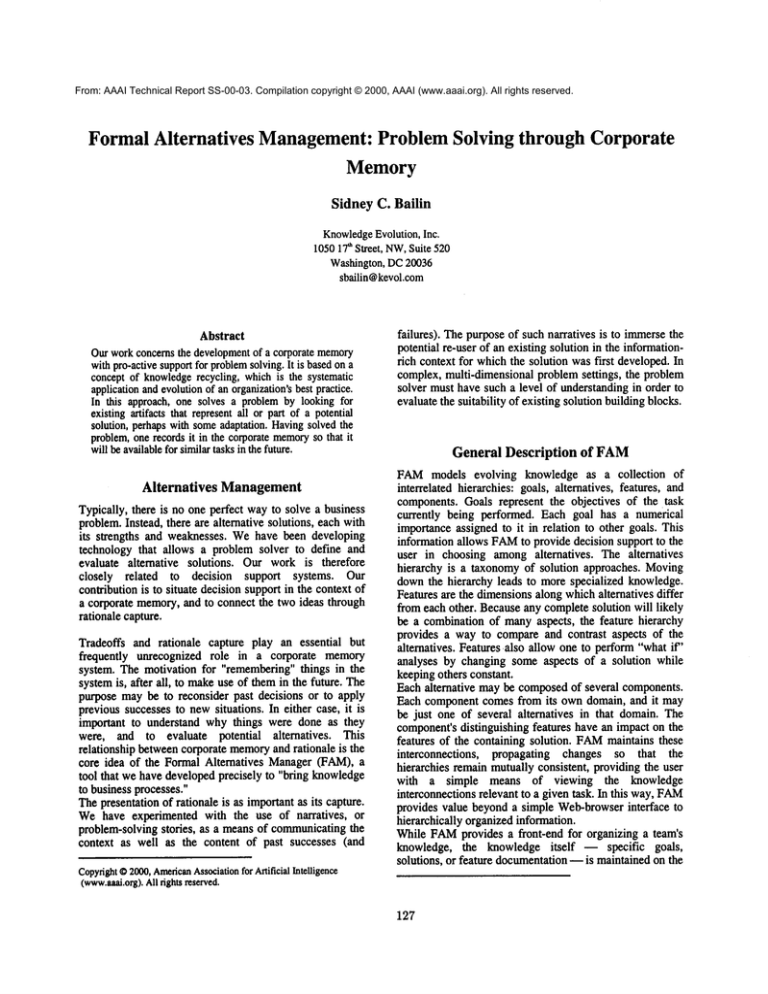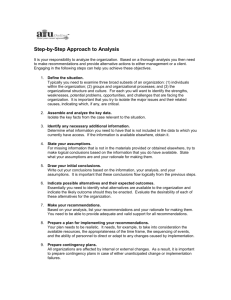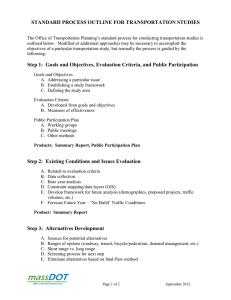
From: AAAI Technical Report SS-00-03. Compilation copyright © 2000, AAAI (www.aaai.org). All rights reserved.
Formal Alternatives
Management:Problem Solving through Corporate
Memory
Sidney C. Bailin
Knowledge
Evolution,Inc.
105017~ Street, NW,Suite 520
Washington,DC20036
sbailin@kevol.com
Abstract
Our workconcernsthe development
of a corporatememory
withpro-activesupportfor problem
solving.It is basedon a
conceptof knowledge
recycling, whichis the systematic
applicationandevolutionof an organization’s
best practice.
In this approach, one solves a problemby looking for
existing artifacts that representall or part of a potential
solution, perhapswithsomeadaptation.Havingsolvedthe
problem,onerecordsit in the corporatememory
so that it
will beavailablefor similartasksin the future.
Alternatives
Management
Typically, there is no one perfect wayto solve a business
problem.Instead, there are alternative solutions, each with
its strengths and weaknesses. Wehave been developing
technology that allows a problem solver to define and
evaluate alternative solutions. Our work is therefore
closely related to decision support systems. Our
contributionis to situate decision supportin the context of
a corporate memory,and to connect the two ideas through
rationale capture.
Tradeoffs and rationale capture play an essential but
frequently unrecognized role in a corporate memory
system. The motivation for "remembering"things in the
systemis, after all, to makeuse of themin the future. The
purpose maybe to reconsider past decisions or to apply
previoussuccesses to newsituations. In either case, it is
important to understand why things were done as they
were, and to evaluate potential alternatives.
This
relationship betweencorporate memory
and rationale is the
core idea of the Formal Alternatives Manager(FAM),
tool that we have developedprecisely to "bring knowledge
to businessprocesses."
Thepresentationof rationale is as importantas its capture.
Wehave experimented with the use of narratives, or
problem-solvingstories, as a meansof communicating
the
context as well as the content of past successes (and
Copyright
©2000,American
Association
for ArtificialIntelligence
(www.anai.org).
Allrightsreserved.
failures). The purposeof such narratives is to immersethe
potential re-user of an existing solution in the informationrich context for whichthe solution was first developed.In
complex,multi-dimensional problemsettings, the problem
solver must have such a level of understandingin order to
evaluatethe suitability of existing solution buildingblocks.
General
Description
of FAM
FAN[ models evolving knowledge as a collection of
interrelated hierarchies: goals, alternatives, features, and
components.Goals represent the objectives of the task
currently being performed. Each goal has a numerical
importanceassigned to it in relation to other goals. This
information allows FAM
to provide decision support to the
user in choosing amongalternatives. The alternatives
hierarchy is a taxonomyof solution approaches. Moving
downthe hierarchy leads to morespecialized knowledge.
Features are the dimensionsalong whichalternatives differ
from each other. Becauseany completesolution will likely
be a combinationof manyaspects, the feature hierarchy
provides a way to compareand contrast aspects of the
alternatives. Features also allow one to perform"whatif’
analyses by changing some aspects of a solution while
keepingothers constant.
Each alternative maybe composedof several components.
Each componentcomes from its own domain, and it may
be just one of several alternatives in that domain. The
component’sdistinguishing features have an impact on the
features of the containing solution. FAM
maintains these
interconnections,
propagating changes so that the
hierarchies remainmutually consistent, providingthe user
with a simple means of viewing the knowledge
interconnectionsrelevant to a given task. In this way,FAM
provides value beyond a simple Web-browserinterface to
hierarchically organizedinformation.
While FAMprovides a front-end for organizing a team’s
knowledge, the knowledge itself- specific goals,
solutions, or feature documentationn is maintainedon the
127
Web. FAMuses a web browser to display this content.
FAMitself maintains recta-information
about the
relationships betweenpieces of this knowledge.
Detailed
Description
of FAM
FAMmodels the space of alternatives through four
interconnected models:
¯ Goals
¯ Alternatives
¯ Features
¯ Components
Eachof these is structuredas a tree, the first three of which
are is-a hierarchies. Thecomponenttree is an aggregation
hierarchy. The Alternatives, Features, and Components
modelsare not orthogonal: they constrain each other in a
numberof subtle ways. Before describing these interrelations, weexplain what each modelrepresents in its own
right.
Alternatives
This is a taxonomic model of possible solutions, or
solution techniques, for a given type of problem. The
solutions need not be complete. Thosethat occur at nonleaf positions in the hierarchy are partially specified,
representing an incomplete set of commitments,to which
further commitmentsmust be added in order to put the
solution into practice. Leavesin the hierarchy mayalso be
partial solutions, or they maybe relatively complete,
meaningthat they address all of the questions currently
consideredsignificant.
The Alternatives modelis intended to provide the problem
solver with a guided path towards a solution that best
meets the goals of the current task. The root node of the
hierarchy represents the task itself. Eachstep downa path
of the hierarchy represents a decision to adopt one
approachover others. This "decision" mayin fact consist
of several fine-grained decisions, binding (or constraining)
several degrees of freedomat once.
For each step downa path in the Alternatives hierarchy,
there is a rationale: a reason for adopting this approach
over its alternatives. There maybe several such reasons,
suchas:
¯ Recognizedadvantages(or disadvantages) to a given
approach
¯ Distinct stakeholdersapplyingdifferent criteria but
arriving at the samechoice
The meaningof the rationale maydependon the context in
which the modelwas created. For example:
¯ Hereis whywe adoptedthis approachover its
alternatives
¯ Here is whywe considered this approach
¯ Here is whywe rejected this approach
¯ Here is whyyou might want to adopt this approachover
its alternatives
Features
Each node in the Alternatives hierarchy represents a
distinct, possibly incomplete,solution to a certain type of
problem. The solutions are distinguished from each other
throughfeatures.
The Features modelis a forest representing the different
dimensions of variability (degrees of freedom) of
solution. Each"dimension"is an aspect of the design about
which decisions can (or must) be made. Although the
dimensionsare distinct from each other, they maynot be
completely independent. Commitmentsand restrictions,
such as "Selecting feature X commitsyou to selecting
feature Y," or "Selecting feature U prevents you from
selecting feature V," are a frequent and important
considerationin the solution developmentprocess.
Each step downa path in the Features modelrepresents a
constraint on the solution dimensionbeing considered. The
impliedconstraint is one of twothings:
¯ A limitation of the scopeof the dimension,as in the
following features of Automobiles:
Color
Body color
Interior color
¯ A limitation of the admissibledecisions concerningthis
dimensionof the problem;for example:
Color
Pastel color
Neon color
The two types of constraint correspond to "and" and "or"
branching, respectively. In the first case, the meaningof
the dimension is mademore precise; in the second case,
the meaningstays the same, but the available values to
which the solution maybe boundare reduced. The former
type represents a definition, while the latter type represents
a decision.
Relationship between Alternatives and Features
Features are assigned to alternatives. The assignmentis
understoodto meanthat the alternative "has" that feature.
This is the primary meansof distinguishing betweenone
alternative and another.
Since a solution corresponds to a set of features, the
semantics of the Alternatives taxonomyand the Features
taxonomyare distinct but related. Specialization of an
alternative consists of specializing one or more of its
features, or addingnewfeatures. This is a constraint on the
mutual consistency of the Alternatives model and the
Features model, and it is enforced automatically by FAM.
Features and Tradeoffs
Since "or"-type features represent commitments,they may
contribute to or detract from the realization of goals.
Commitments
typically involve trading somegoals against
128
other goals. This informationis modeledexplicitly in FAM
by means of a "goodness" measure, which indicates a
feature’s degree of goodness (or badness, considered as
negativegoodness)for a givengoal. It is quite possible for
a feature to be irrelevant to the achievement
of a particular
goal. If, however,a feature is irrelevant to the achievement
of all stated goals, then either the feature is superfluousor
the goals havenot beencompletelyarticulated.
Theis-a semanticsof the Featuresmodelentails constraints
on the goodnessmeasures.If a feature F is recognizedto
have goodness(or badness)r, then any specialization of
must be at least as good (or bad). FAMautomatically
enforcesthis constraint.
Goals themselves may be weighted. Goal weights
influence a feature’s "overall" goodness,averagedover all
declared goals. Analternative, in turn, has an "inferred"
goodnessfor each goal (averagedover all of its features),
and an "overall" goodness (inferred goodness averaged
overall declaredgoals).
engines as a feature of sports cars, which serves to
distinguishsports cars fromcars in general.
Similarly, station-wagons mayrequire 8-cylinder engines
to support their size and expected load. Theyneed not be
V8 engines, however. In the decomposition model for
station wagons,therefore, the role of Enginewill be played
by the design called "8-cylinder Engine"and this fact will
appear as a feature of Station Wagons.
The Features Modelfor Automobilenowcontains features
that distinguish betweenSports Cars and Station Wagons.
The distinction between the two types of Automobilesis
represented in the Features modelfor Cars. This is true
even if the distinction concerns a still lower-level
component,such as type of valves used within the engines.
In this way, FAMhelps the problem solver coordinate
tradeoffs and decisions at different levels of the solution
design.
Related
Components
The fourth type of modelthat FAM
uses to represent the
space of solution alternatives is an aggregationhierarchy.
Solutions, whetherthey are plans, systems, or other types
of artifacts, are composed
of subparts, whichare composed
of smaller components,and so on to arbitrary depth. Each
componentof a larger solution has features in its own
right, about which tradeoffs must be considered and
decisions must be made. For this reason, FAMsituates a
componentwithin the space of alternatives appropriate to
the component’sdomain. An Alternative decomposesinto
components,each of whichis, itself, an Alternative in an
appropriate domain, and so on, recursively downthe
decompositionhierarchy.
Decomposinga solution into components is a type of
decision. Alternative decompositions are one way to
distinguish one solution from another. FAMautomatically
enforces certain relationships betweenthe Alternatives,
Features, and Componentsmodels. For example, consider
a set of alternative designs for Automobiles, which
classifies cars into Sports Cars, FamilyCars, and Utility
Vehicles. Familycars are further classified into Sedansand
Station Wagons.Certain componentsare found in all cars,
e.g., Engine, Transmission, Fuel System, CoolingSystem,
etc. These constitute the componentmodelfor the general
design of Automobiles.Each of these componentsdefines
a role that the component
plays within the overall design of
a Car.
Specific types of cars will, by default, inherit the
componentsof the general car design. They may,however,
override some of these components with more specific
componentdesigns. For example, Sports Cars maycontain
only V8engines, whichare a specialization of the general
design of engines. The decomposition for Sports Car
would then contain "V8 Engine" in the role played by
"Engine" in the general car design. This is admissible
because "V8Engine" occurs in the Alternatives modelfor
Engines. FAMflags the fact that sports cars contain V8
Work
FAMis situated at the intersection of Decision Support,
Case-Based Reasoning (CBR), and Rationale Capture
tools. The tradeoff algorithms currently implementedin
FAMare rather simplistic, and we intend to replace them
with sharper algorithms found in the decision support
literature, such as the Analytic Hierarchy Process. The
knowledgerecycling process on which FAMis based is
essentially a CBRparadigm. The emphasis in CBRtends
to be on automated techniques for matching solutions to
problem statements, while FAMcurrently applies only a
simple text-search function and relies on user intelligence
to identify relevant cases. The path to employingmore
automated CBRalgorithms is, however, clear. Finally,
rationale capture has been explored in contexts such as
cooperative work, concurrent engineering, and related
fields. Methodologiessuch as IBIS makethe connection
betweenrationale capture and corporate memory,but not
with corporate memorystructured as a case base. When
these three disciplines are combined,certain knowledge
managementissues arise, which the FAMstructures
(described above)attempt to address.
References
Conklin, J., and Begeman,M. 1988. gIBIS: A Hypertext
Tool for Exploratory
Policy Discussion.
ACM
Transactionson Office InformationSystems 6(4):303-331.
Saaty T.L. 1980. The Analytic HierarchyProcess. New
York,NY:McGrawHill.
Schank,R., Kass, A., and Riesbeck, C., eds. 1994. Inside
Case-Based Explanation. Hillsdake, N J: Lawrence
ErlbaumAssociates.
129





